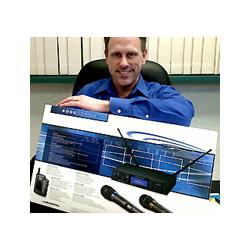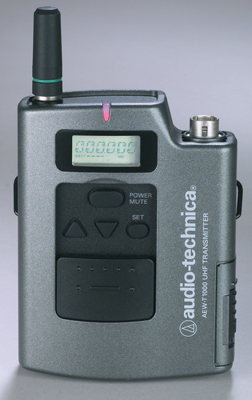
In our shop, I plugged in the receiver’s power cable and fed it to an input on a small portable system, put the batteries in the transmitters, turned it all on, and everything worked flawlessly right out of the box.
An early observation is the feel of both the handheld and belt pack transmitters. The handheld “metal case” is weighty – the good kind of weighty – not heavy as in “I don’t want to hold this for two hours” and not light as in “this feels like a flimsy piece of junk.”
The belt pack was the same, and in terms of physical size, it’s big enough that you feel something secured to your belt but not so big that you feel like you’ve grown a new appendage.
Dual Service Use
To get a real feel of how this system actually works and sounds, I next deployed it on my Sunday morning gig, starting by using the AEW-T3300 handheld transmitter with the lead vocalist for our contemporary worship services.
The transmitter features the same cardioid condenser element used in the very well-received AT4033 microphone, and as I listened to the vocalist, the overall sonic signature was pristine.
.
This can be credited in part to the mic element, but I also believe the dual compander circuitry of the 4000 Series wireless, which processes high and low frequencies separately, enhances the exceptional clarity I heard in the vocal.
Later, for traditional services, I asked the pastor to try out the UniPak belt pack transmitter and MicroSet condenser headworn microphone. He was hesitant, having previously switched to a headset mic that took him months to get adjusted “just right”. As a result, he didn’t want to change to a different headset – very understandable.
But I persisted and he eventually consented, and pretty quickly, he’d gotten the A-T headset at a comfortable position, to the point where he used it throughout the entire service.
As is normal with headset mics, I still needed to do a final adjustment on the mic placement – he’d inadvertently positioned it so close to his face that the mic element tapped the corner of his mouth when he talked more demonstrably.
Further, the pastor really liked the belt pack transmitter, both the way it fit snuggly and didn’t slide around, as well as the sliding door that protects the unit’s control buttons. A few years ago, he had the misfortune of accidentally leaving his transmitter on while visiting the restroom, so he’s exceptionally dogged about being sure it’s turned off before leaving the platform.
Related, of course, he’s also notorious for then forgetting to turn the transmitter back on when he returns, frantically scrambling for the button while on stage. The dual action presented by the sliding door on the A-T belt pack transmitter makes the on/off process more concrete, which he said helped him better keep in mind whether the unit was on or off.
.
Further, he no longer worried about the belt pack accidentally being turned off when he moved around on the platform.
Later I realized that the lock out feature on the transmitter would be another benefit in this regard, allowing the system operator to lock the power on while allowing muting capability. This allows the user to “go silent” for private moments without having to power down, and more painfully, wait for the transmitter to power back up.
Feature Rich
Following services, I sat down with the product manual and went through the feature set, reading and then pushing buttons on the system, quickly getting comfortable and familiar with all operating parameters. It wasn’t hard, and the manual is concise and well written. You can read about all of the features and specifications here, but I’d like to highlight a couple of them.
IntelliScan – In basic terms, IntelliScan allows the easy linking of numerous 4000 (or 5000) Series systems together. One system is set as the “master” while the others in the loop are incorporated in the network as well.
Push a button on the master receiver, and IntelliScan calculates the best frequencies for all receivers in the loop by using a built-in frequency plan that is mapped against the local interference sources it detects.
Presets & Control – How many times have you seen the tacky colored tape on wireless mics in order to keep them organized? (And yes, I can say it’s tacky because I’ve used this method.)
The 4000 Series addresses this with an easy-to-use preset function. A menu permits the storing of up to five different user-definable configurations, as well as customized names, can be created and stored for presets 1–5. All of this information can be clearly seen on the transmitter’s LCD display.
Once a preset is established, a digitally encoded tone communicates the transmitter data for receiver display. Both receiver and transmitter also display the transmitter’s battery, mute, locked status.
This is really handy in applications like mine, where we have two separate and often very different services using the same wireless resources.
For example, a preset for “Mary,” our operatic soprano who sings in the traditional service, needs a -6 dB cut to avoid distortion that rivals a guitar pedal. She also can’t be given any control over power or mute, because invariably, she sets it wrong.
Meanwhile, a preset for “Beth,” a vocalist in our contemporary services with a softer voice, is set to provide +6 dB in level. She’s much more reliable on the controls, so her preset allows her to mute when she wants. (But not power off.)
As a result, two diverse participants can share the same wireless system, and other than loading the preset prior to each one’s service, I’m off the hook.
It’s so great that it counters the nostalgia I’m invariably going to feel when thinking about that yellow, blue, green, pink and red tape wrapped around our mics in the “good old days.”
Speaking of “wrapped,” it’s time for me to wrap up my remarks.
As I noted at the outset, few of us are comfortable thinking about investing big money at this point in time. And if we’re honest, it’s these restrictions that make us work harder and think smarter.
When we do this, we realize that sometimes the biggest improvements in a church sound system can come from smaller packages. And often, the best place to start in terms of improvement is at the source; in other words, the microphones capturing the performance must be of quality, or the rest, literally, is just noise.
If you’re thinking along these lines, consider upgrading your wireless. As I can testify with the Audio-Technica 4000 Series system, it’s a solid place to start in terms of making a big difference.
Gary Zandstra is a professional AV systems integrator and has been involved with sound at his church for more than 25 years.
More Church Sound articles by Gary Zandstra:
Testing Cables Is Essential To Solid Church Sound System Performance
Two Simple Yet Vital Tools Of The Trade For Church Sound Operators
Also check out:
Basic & Essential: What You Need To Know About Wireless Systems
And:
Be sure to enter the PSW Sweepstakes (click here) for the chance to win a premium Audio-Technica BP4025 ($749 MSRP) or an Audio-Technica AT8022 stereo microphone ($499 MSRP)



